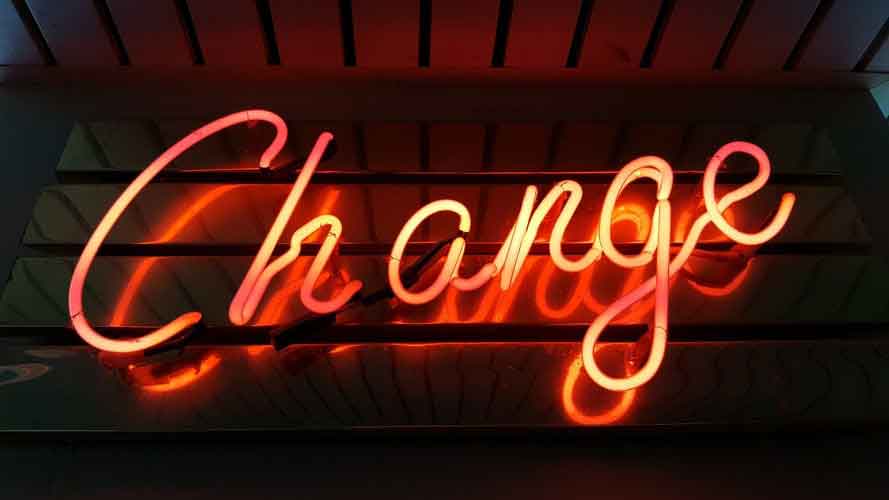It’s been said a thousand times and a hundred different ways, but it’s still true: the only constant in life is change. Unfortunately, it’s also one of the most difficult things to do, especially when your company’s brand is at stake.
In many cases, however, a name change is an opportunity in disguise. It’s a chance to align your brand with the future, whether it’s the future of your company or the world. Still, it’s not something to rush into. Pulling off a new name takes a lot of careful consideration, and the first step is deciding whether or not a name change is actually the right move. Here are some situations when it just might be.
When your company is changing
Companies are human creations, and like anything man-made, they evolve and change over time. Maybe you’ve shifted your business model to include new verticals or focus on new technologies. Maybe you’ve acquired a new subsidiary and now your old name no longer reflects what you do.
Either way, there’s no shame in changing your name if it just doesn’t serve you anymore. In fact, some of the world’s most popular companies have done just that:
- PayPal: PayPal used to go by the more corporate-sounding Confinity—until they discovered a way to send payments via email. Then their whole business model changed, including their name.
- Dunkin’ (formerly Dunkin’ Donuts): More recently, the beloved donut chain Dunkin’ Donuts officially changed its name to Dunkin’ to reflect its expanding menu. After all, they were already using the shortened version in their slogan “America runs on Dunkin’.”
When the world is changing
Einstein once said, “The measure of intelligence is the ability to change.” It’s also the measure of a successful business. Companies that keep their finger on the pulse of cultural trends are the ones destined to survive the inevitable march of time.
- WW (formerly Weight Watchers): Back in the heyday of diet pills and magazine headlines like “Drop 10 Pounds in a Day,” the name Weight Watchers seemed completely reasonable in a sea of products touting weight loss by any means possible. Now, though, things have changed. Consumers’ interests have shifted to embrace products that promote health and wellness—whether or not that means shedding a few pounds. In 2018, Weight Watchers followed suit, officially renaming itself to the shorter, more modern name WW with a new tagline, “Wellness that Works.”
- Clorox. The company that would come to be known as Clorox started off as the much less catchy Electro-Alkaline Company. As bleach became a household staple, though, consumers began calling it “clorox,” a combination of the two main ingredients, chlorine and sodium hydroxide. Clorox took advantage of that linguistic shift and took it as their name — and the rest is history.
When you need to disassociate from the past
Every company makes a PR mistake or two, but some errors are just too disastrous to overcome. Bad press, bad management or an unfortunate turn of events are all reasons to recreate yourself with a new name. Here are a few businesses that made the transition:
- AirTran Airways. In 1996, ValuJet Flight 592 crashed ten minutes after taking off, killing everyone on board. In the wake of that tragedy — and the FAA investigation that followed — ValuJet officially rebranded as AirTran Airways.
- The Livestrong Foundation. After Lance Armstrong admitted to using performance enhancement drugs, his foundation, then known as the Lance Armstrong Foundation, decided it was best to distance itself from its founder. In 2012, they officially changed their name to the Livestrong Foundation and limited Armstrong’s involvement in the foundation’s work.
When there’s a trademark conflict
By far, one of the most common reasons companies embark on a renaming exercise is because they’ve been notified of potential trademark infringement. While some companies do take these challenges to court, for many, it’s smarter to simply opt for a new name, especially if there isn’t clear evidence they claimed the name first.
You don’t have to be a newcomer or a small business to run into the problem. Some very well-known brands have been through the process and lived to tell about it:
- WWE. Before 2002, the WWE went by its original moniker, World Wrestling Federation, or WWF for short. That didn’t sit well with the World Wildlife Foundation, who had been using the acronym WWF for decades. In a high-profile trademark infringement lawsuit, judges upheld the World Wildlife Fund’s claim on the initials, leaving the wrestling group no choice but to change their name to World Wrestling Entertainment, or WWE.
- Playboy. It’s hard to imagine it going by any other name, but when Hugh Hefner first launched the iconic magazine in 1953 as Stag Party, one cease-and-desist letter later and he switched to the indelible Playboy. That turned out to be a smart decision for Heffner; after all, Stag Party Mansion just doesn’t have the same ring to it.
The decision to change your name is a big one, and this list is by no means a comprehensive catalog of all the reasons companies decide to do so. No matter why you decide to make the change, navigating the transition takes careful thought, planning, savviness — and of course, just the right name.
At NameStormers, we have helped hundreds of businesses generate names that have helped them transcend their pasts and vault themselves into a new chapter of their company’s history. To learn more, check out our naming process — or get in touch with us now to start brainstorming new names right away!



